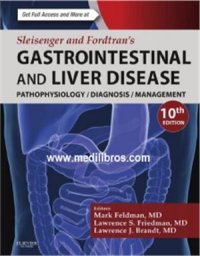
Ebook: Sleisenger and Fordtran’s Gastrointestinal and Liver Disease Part 3
Author: Feldman М.
- Genre: Medicine
- Tags: Медицинские дисциплины, Гастроэнтерология и гепатология
- Language: English
- pdf
Elsevier, 2015 - 1032p.
10th editionThe tenth edition of Sleisenger and Fordtran’s Gastrointestinal and Liver Disease: Pathophysiology/Diagnosis/Management continues as the benchmark textbook of gastroenterology and hepatology. It is authoritative, comprehensive, and, although encyclopedic in its coverage, very readable. The editors have done an excellent job ensuring that the organization of chapters is uniform. Thus, chapters have sections on epidemiology, etiology, pathology, pathophysiology, clinical features, diagnosis, differential diagnosis, treatment, and prognosis. This uniform format allows readers to search easily for information under different subheadings to fid answers to their questions. As noted in the Preface, the content of the book has changed dramatically in the 42 years since the fist edition was published in 1973. Whereas the fist edition had 115 chapters
and the tenth edition has 132, the additional 17 chapters belie the masterly job the contributors and editors have done in preserving references not only to classic articles but also to
the important new advances that have occurred between publications of successive editions. This newer material also includes references that have been updated to include articles published into 2014. As also noted in the Preface, some of the new chapters include up-to-date discussions of enteric microbiota, probiotics and fecal transplantation, and factitious gastrointestinal diseases. An outstanding feature of the textbook is the clarity and detail of the tables and the high quality
of the photomicrographs.
The tenth edition of Sleisenger and Fordtran will continue to be a premier textbook, as was the case with its predecessors, and will be especially useful to medical residents, gastroenterology fellows, and gastroenterologists. Finally, I can personally attest to the remarkable advances that have been made, as I was author of the chapter on eosinophilic gastroenteritis in the second edition of the textbook, and reading the same chapter in the tenth edition underscores the important advances that have been made in our understanding of the molecular basis as well as the pathophysiology of this and related disorders.
10th editionThe tenth edition of Sleisenger and Fordtran’s Gastrointestinal and Liver Disease: Pathophysiology/Diagnosis/Management continues as the benchmark textbook of gastroenterology and hepatology. It is authoritative, comprehensive, and, although encyclopedic in its coverage, very readable. The editors have done an excellent job ensuring that the organization of chapters is uniform. Thus, chapters have sections on epidemiology, etiology, pathology, pathophysiology, clinical features, diagnosis, differential diagnosis, treatment, and prognosis. This uniform format allows readers to search easily for information under different subheadings to fid answers to their questions. As noted in the Preface, the content of the book has changed dramatically in the 42 years since the fist edition was published in 1973. Whereas the fist edition had 115 chapters
and the tenth edition has 132, the additional 17 chapters belie the masterly job the contributors and editors have done in preserving references not only to classic articles but also to
the important new advances that have occurred between publications of successive editions. This newer material also includes references that have been updated to include articles published into 2014. As also noted in the Preface, some of the new chapters include up-to-date discussions of enteric microbiota, probiotics and fecal transplantation, and factitious gastrointestinal diseases. An outstanding feature of the textbook is the clarity and detail of the tables and the high quality
of the photomicrographs.
The tenth edition of Sleisenger and Fordtran will continue to be a premier textbook, as was the case with its predecessors, and will be especially useful to medical residents, gastroenterology fellows, and gastroenterologists. Finally, I can personally attest to the remarkable advances that have been made, as I was author of the chapter on eosinophilic gastroenteritis in the second edition of the textbook, and reading the same chapter in the tenth edition underscores the important advances that have been made in our understanding of the molecular basis as well as the pathophysiology of this and related disorders.
Download the book Sleisenger and Fordtran’s Gastrointestinal and Liver Disease Part 3 for free or read online
Continue reading on any device:

Last viewed books
Related books
{related-news}
Comments (0)